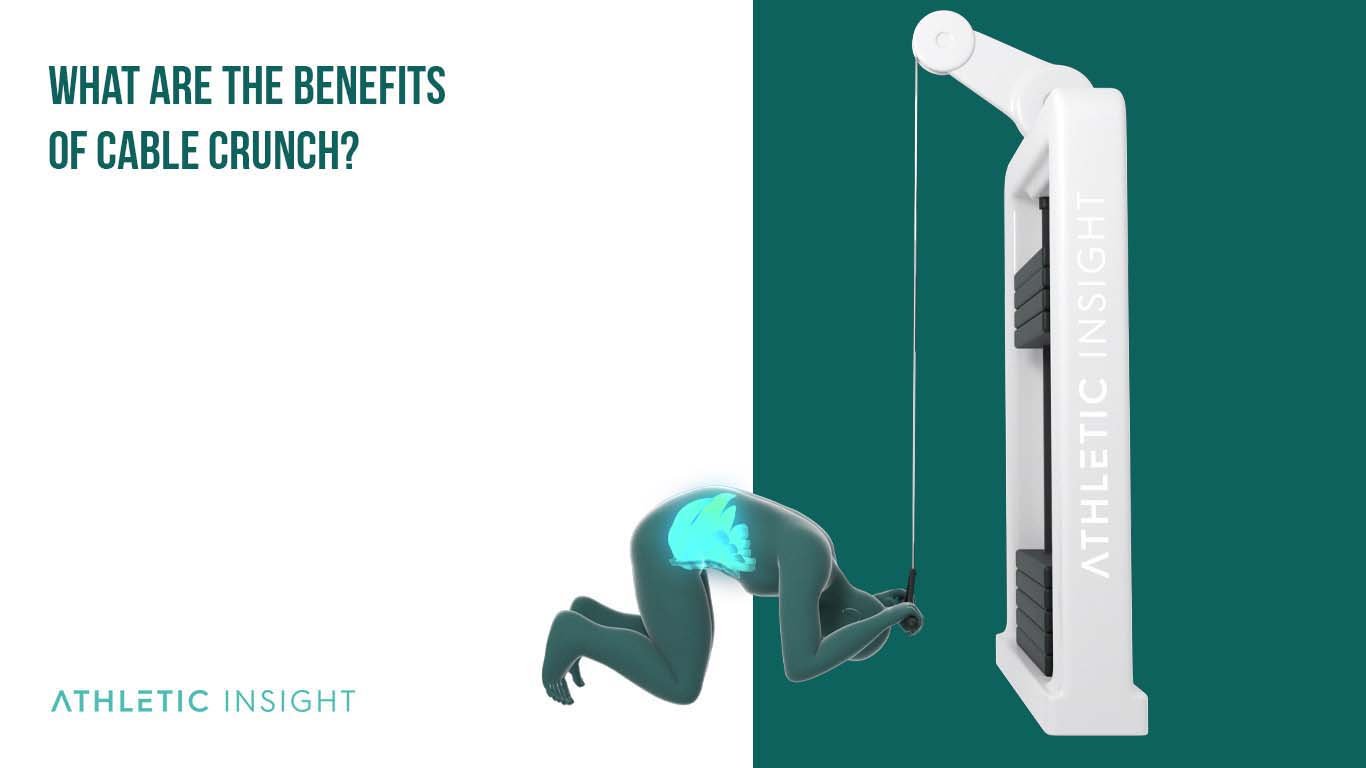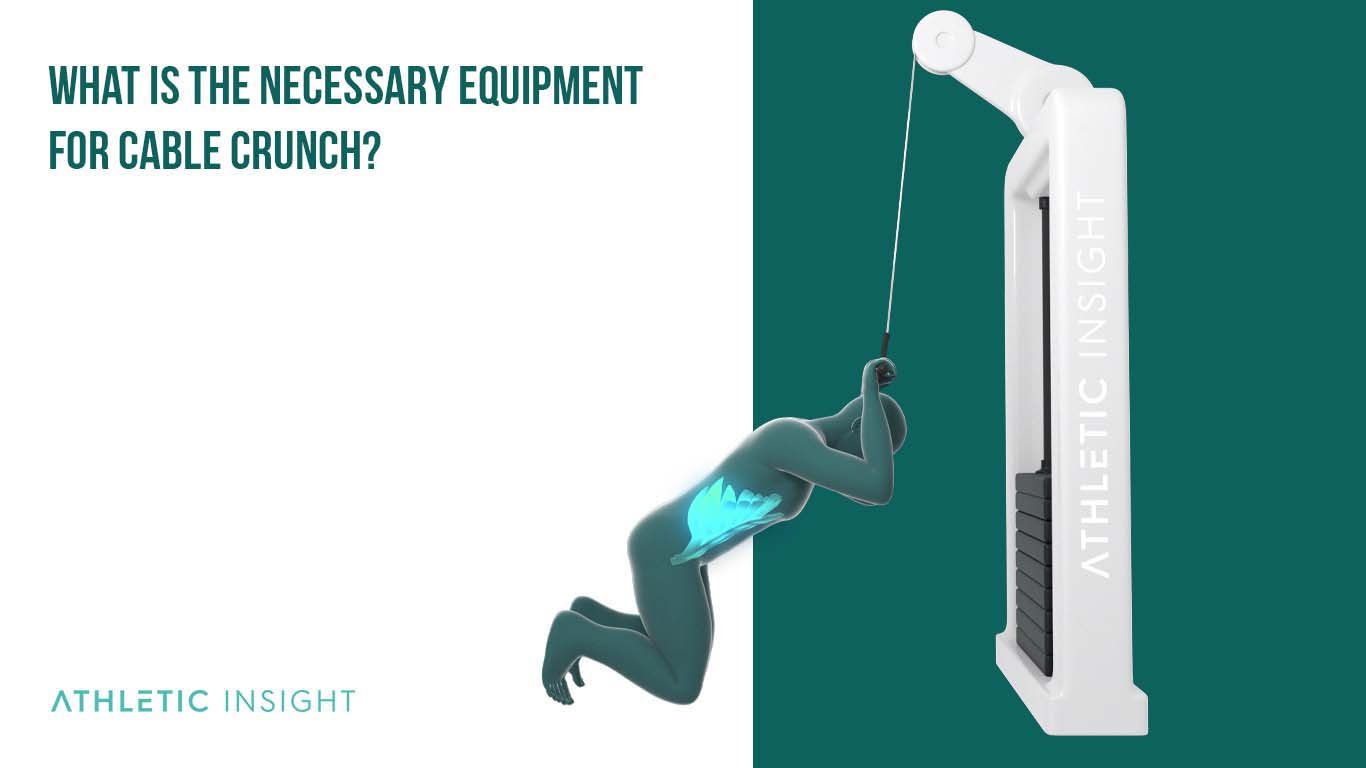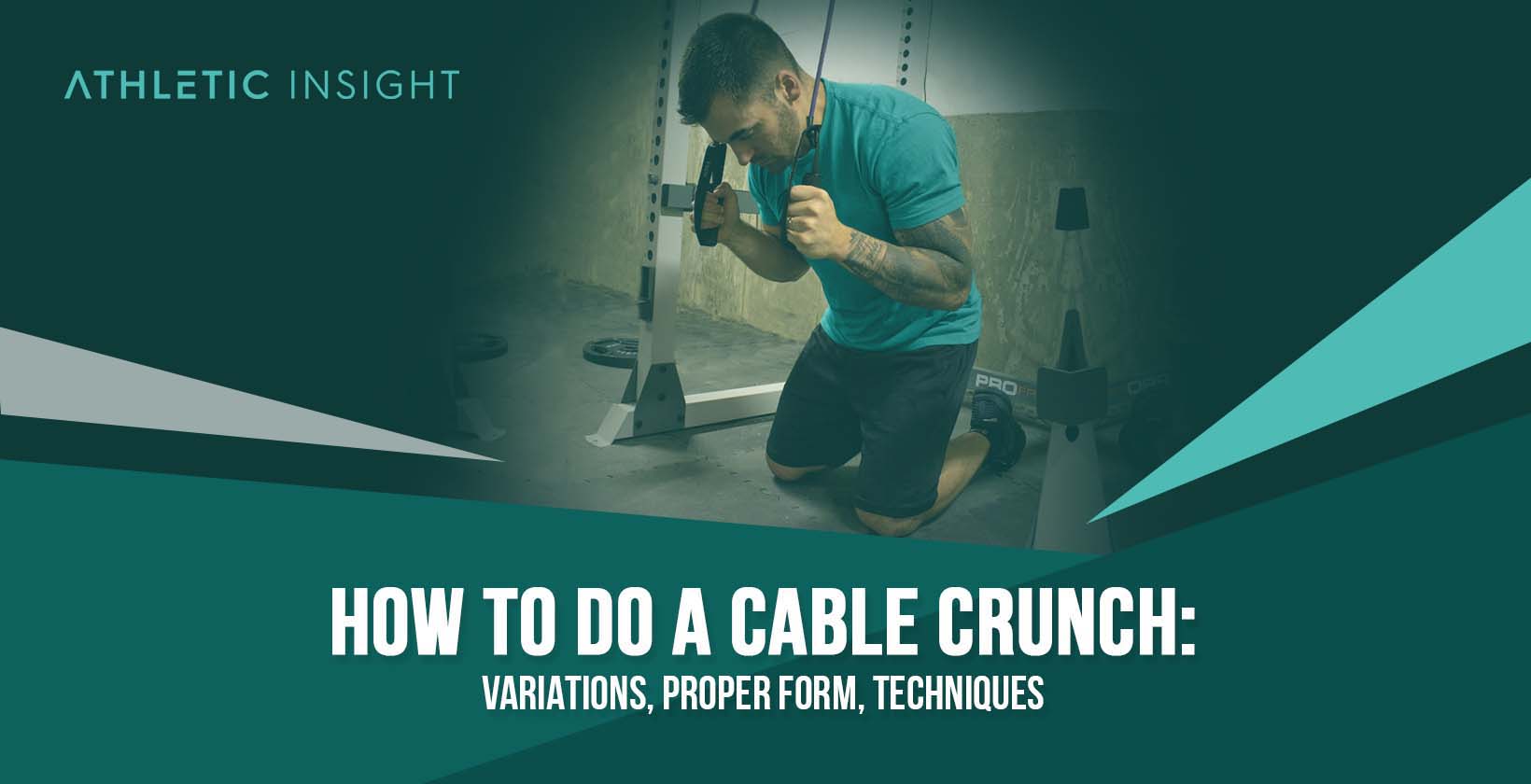The cable crunch is an ab workout with rope pulldown using a pulley machine and bending forward at the waist to lift the weights. Benefits of the cable crunch include isolating the abs and engaging the entire core without stressing the spine. It’s also an excellent choice for beginners.
Performing the cable crunch allows lifters to work the upper and lower abs and the obliques to build strength and stability.
Proper cable crunch techniques involve kneeling on the floor in front of a pulley machine with a double-grip rope attached. Grasp the rope handles, keeping the back in line and core engaged. Bend at the waist until the head reaches the floor. The rope handles should be at either side of the head. Slowly return to the starting position and repeat.
There are four variations of the cable crunch, the seated version, the kneeling version, the standing version, and the twist.
The main cable crunch mistakes involve using too much weight or improper form, especially relying on the arms instead of the core muscle. Common injuries would be abdominal strains and potential rotator cuff injuries due to excessive weight and improper form.
Using a proper form with weighted rope crunches is crucial to master the cable crunch, prevent injury, and allow the athlete to target the abdominal muscles. Lifters won’t see improvement or build muscle if they don’t follow proper form.
How to Perform Cable Crunch with Proper Form?
Athletes who want to make gains in strength while increasing definition in the abdominals can perform the cable crunch. It’s an alternative to traditional crunches that requires the proper form to engage the muscles without overextending them to the point of injury.
Follow these steps to dominate cable crunch.
- Set a cable station pulley to the highest setting
- Stand a few feet in front of the cable machine with a bench.
- Put a rope handle on the pulley.
- Grab the handle.
- Sit on the machine with hands above the head.
- Crunch forward and down, with the mid spine as the pivot point.
- Bring your elbows down toward the thighs.
- Return to the beginning position by contracting the abs.
Proper form is crucial for preventing injury and making gains in strength and mass.
1. Set a Cable Station Pulley to the Highest Setting.
Select the weight resistance and level so that it’s comfortable to reach the handle from a kneeling position. The athlete needs to be able to pull the weight down far enough for the head to reach the ground.
2. Stand a Few Feet in Front of the Cable Machine with a Bench.
Standing too close or too far from the machine can interfere with a lifter’s form and cause them to strain.
3. Put a Rope Handle on the Pulley.
Choose a double-grip rope handle and attach it to the machine. This handle allows the lifter to keep their hands on either side of the head to maintain correct form throughout the exercise.
4. Grab the Handle.
Grasp the handle with both hands. Hold it firmly but not too tight.
5. Sit on the Machine with Hands Above the Head.
Start with the hands over the head, slightly hinged at the waist. Tuck the head toward the chest to avoid stressing the cervical spine.
6. Crunch Forward and Down, with the Mid Spine as the Pivot Point.
Keeping the entire lower body stable, engage the abs and hinge forward at the waist.
7. Bring Your Elbows Down Toward the Thighs.
Slowly move the elbows and head down. Stop when the elbows reach the thighs.
8. Return to the Beginning Position by Contracting the Abs.
Slowly return to the starting position, relying on the abs throughout the motion.
What Are the Benefits of Cable Crunch?
Adding weighted cable crunches to an ab workout routine makes an excellent alternative to the traditional version. There are several reasons to choose abdominal cable crunches.

- Cable crunches can enhance your core strength and stability
- Cable crunches are easily adjustable
- Cable crunches can improve your posture
1. Cable Crunches Can Enhance Your Core Strength and Stability
The cable crunch is excellent for athletes who want a strong core and sculpted abs. It’s an excellent way to build strength for compound exercises, like deadlifts and bench presses.
2. Cable Crunches Are Easily Adjustable
Doing ab cable crunches is easier for beginners. However, experienced lifters can add weight and isolate the various muscles for a better workout.
3. Cable Crunches Can Improve Your Posture
Cable rope crunches build strength and stability throughout the core, which supports good posture.
What Are the Mistakes for Cable Crunch Form?
Good cable crunch form is necessary to avoid injury and see gains. However, there are some common cable crunch mistakes that even skilled lifters commit from time to time.
- Not Rounding the Back: The cable crunch form requires the athlete to keep the back slightly rounded to allow the erectors a chance to work. If the erectors can’t do their thing, then the abs can’t contract, and the exercise accomplishes nothing.
- Using Too Much Weight: Using excessive weight is a frequent issue with many exercises. Remember that lighter is better because the form is more important than maxing out.
- Too Much Stress on the C-spine: Tucking the chin slightly is a must, but pulling the chin all the way into the chest is a no-no because it stresses the cervical spine.
- Relying on the Arms: This exercise is not about the arms, so relying on them to do the work won’t engage the abs enough to make a difference.
What Is the Importance of Breathing for Cable Crunch?
Like all other exercises, breathing technique is crucial during cable machine crunches. It’s a key step in engaging the necessary muscles throughout the workout. Athletes should exhale before beginning the cable crunch, inhale on the way down, and then exhale again on the way back to the starting position. Using this method allows the athlete to control their movements better and enhance the exercise.

Which Muscles Are Involved While Performing Cable Crunch?
The cable ab crunch works the core, more specifically two sets of muscles.
- Rectus Abdominis: This muscle group, also known as the “six-pack ab muscles,” is the target for this exercise. Lifters should feel the burn throughout the abdomen to know they engaged these muscles.
- External Obliques: The external obliques wrap around the sides of the body and represent the outermost core muscles, meaning they see secondary work throughout this exercise.
What Is the Necessary Equipment for Cable Crunch?
The cable crunch requires three pieces of equipment; cable pulley machine, double-grip rope handle, the bench. There are 3 types of equipment for cable crunch exercise.

- Cable Pulley Machine: An adjustable cable machine allows the lifter to select the proper weight to serve as resistance throughout the exercise.
- Double-Grip Rope Handle: The double-grip handle allows lifters to move their hands from overhead to the sides to maintain proper form and avoid stressing the neck and upper spine.
- Bench: Sitting on a bench allows the lifter to take the lower body out of the mix and focus on engaging the abs. Alternatively, lifters can kneel on the ground or stand if they don’t want to use a bench.
What Are the Core Muscle Exercises with Cable Crunch?
Many athletes appreciate the cable crunch for core building, primarily because it allows them to isolate the obliques. Cable crunch is one of the best core exercises. Incorporating the cable crunch into a core workout could look something like this:
- Russian Twists: Russian twists are great for lifters at all experience levels, and they work the obliques. It’s possible to hold something, like a balance ball or dumbbell, for an additional challenge in this dynamic exercise.
- Kneeling Cable Crunch with Twist: By kneeling on the ground and adding a twist to the ab cable crunch, lifters can isolate the obliques and feel that stretch through their sides. It’s excellent for building stability throughout the core.
- V-Sit Crunches: This exercise rounds out the core workout since it targets the lower abs for a balanced workout.
What Are the Abs Muscle Exercises with Cable Crunch?
Weight lifters who want to target the abs should incorporate a cable crunch exercise as it is is one of the best abs exercises.
This exercise routine is one example that includes the cable crunch for abs.
- Sit-Ups with 3-Second Hold: Sit-ups are always excellent for focusing on the abdominal muscles, but factoring in a hold allows lifters to isolate them. By holding for three seconds, the workout focuses more on the ab contractions instead of the movement as a whole.
- Kneeling Cable Crunch: Kneeling on the ground requires a little more stability but allows the athlete to isolate the abs throughout the movement. Lifters also have control over how low they go before returning to the starting position.
- Leg Hold: The leg hold makes a relaxing end to the workout because the athlete lies flat on the ground and lifts the legs just enough to contract the abs. Hold for a few seconds before releasing.
What Are the Cable Crunch Related Facts?
There’s much more to learn about cable crunches. Below are 6 Reasons why the Cable Crunch is the best exercise.
Does Cable Crunch Affect the Mood?
Like most exercises, the cable machine ab crunch gets the blood pumping, which increases energy and boosts the mood. Since it targets the abs, the ab exercise also improves posture and appearance, giving athletes a self-confidence spike.
Is Cable Crunch Practiced Within CrossFit?
No, the cable machine ab crunch is not expressly listed as a CrossFit exercise. However, that doesn’t mean some CrossFit athletes don’t use the weighted cable ab crunch to isolate and strengthen their abs.
Is Cable Crunch a Military Movement?
No, the military exercise does not specifically use the cable crunch for any testing or training. Individual recruits might choose cable ab exercises for personal training routines.
Is Cable Crunch Dangerous?
No, the cable crunch is not dangerous as long as lifters use proper form and manageable weight.
Is Cable Crunch an Olympic Lift?
No, the cable crunch is not an Olympic lift. That said, many Olympic lifters and professional weightlifters use some variations of cable ab exercises to strengthen and define their weightlifting abs.
What Can Replace Cable Crunch?
Many exercises can replace the cable crunch, including weighted crunches, abs rollouts, hanging leg raises, and decline bench crunches.
What Are the Alternatives of Cable Crunch?
Athletes can mix up their core and ab workout routines by using alternatives to the cable ab exercise. By swapping equipment, it’s possible to get similar engagement and isolation. Here are eight popular alternatives.
- Weighted Crunch: A weight crunch makes the traditional crunch more challenging by incorporating a weight plate. Lifters hold a weight plate over the chest and move it toward the toes as they roll up in the crunch.
- Ab Crunch Machine: There are several ab crunch machine exercises that use the same general premise. The most common involves sitting upright in a machine and bending forward at the waist or bringing the knees toward the chest. It’s an excellent choice for lifters struggling to maintain proper form with alternative ab exercises.
- Decline Bench Crunch: In the decline bench crunch exercise variation, the athlete uses a decline bench. With the feet hooked in the pads, engage the abs to sit up, then slowly lower back down. The bench provides some stability while increasing the focus on the ab muscles.
- Bosu Crunch: The bosu crunch supports the lifter by introducing a bosu to the lift. Instead of lying on the floor or on a mat, athletes sprawl on the bosu and then crunch up. This variation provides support for the spine throughout the exercise, making it an excellent choice for people who have back pain with the traditional crunches.
- Fit Ball Crunch: Similar to the bosu crunch, the fit ball crunch uses a balance ball beneath the back and buttocks. The ball supports the spine throughout the exercise while engaging the same core muscles as every other variation.
- Ab Wheel Rollout: Experienced athletes who need a challenge might want to try the ab wheel rollout. Lifters start on their knees and grab hold of an ab wheel. They roll out and back in slow, controlled motions, a feat that is much harder than it sounds!
- 90/90 Crunch: 90/90 crunches require no equipment, making them convenient to do anytime, anywhere. Lie flat on the back with hands behind the head and knees at a 90-degree angle. Roll up while keeping the legs up and steady.
- Medicine Ball Sit-Up + Throw: This advanced medicine ball exercise variation requires a medicine ball and a partner or position near a wall. Athletes perform a crunch with a twist. At the top position, throw the medicine ball to a partner or against the wall, then catch it, and roll back down.



